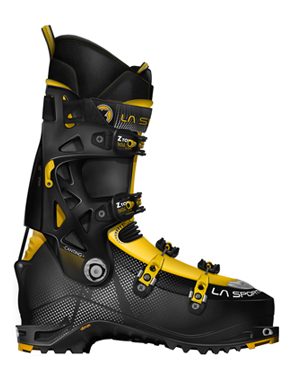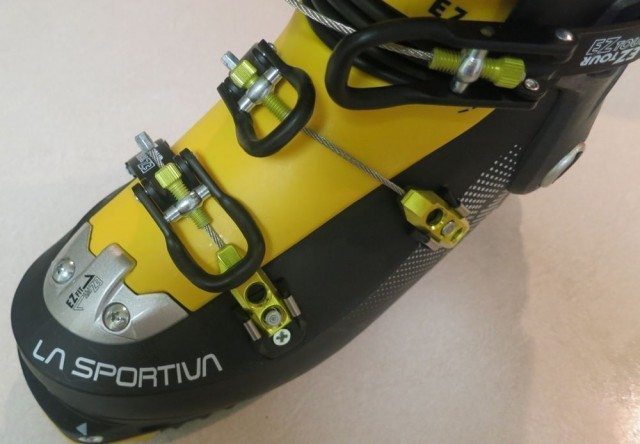
La Sportiva Spectre
Size 27.5
Boot Sole Length: 304mm
Skis: DPS Lotus 138 Pure, 192cm with Dynafit Vertical FT12 set at RV12
MSRP: $599
Stated Weight: 1445g per boot
Blister’s Measured Weight (size 27.5):
- shells, no liners: 1180 & 1185 grams
- stock liners, no footbeds: 243 & 246 g
- shells + liners, no footbeds: 1423 & 1431g
- Boots as Tested:
- 1465 & 1470 g with Intuition Powerwrap Plug liner and insole
Days Tested 15
Location Tested: Hatcher Pass, Alaska
Here’s how La Sportiva describes the Spectre:
“The lightest 4-buckle Alpine Touring boot on the market, the Spectre achieves the greatest range of cuff rotation in its class. The patented design allows a full 60 degrees of ankle movement and the Vertebra construction adds support for downhill performance. The exclusive, low-profile Pegasus buckle system allows macro and micro adjustability for a precise fit. The EZ Flex tongue is designed to work seamlessly with the EZ Flex Liner so that inner and outer boots mesh cleanly while walking or skinning.”
Here are my initial impressions after two days in the Spectre, but first…
Performance Alpine Boot Categories
Before diving into my initial impressions of the Spectre, I wanted to start with a discussion of the various performance alpine boots out there. If you’re still not sure what type of boot you want, this might help clarify a few things.
I think most performance alpine boots fall into the following categories. Granted, as boots continue to evolve, the lines get more and more blurred.
Full Alpine Boots: These boots are usually made of polyurethane (PU) or a similar variation, they have a rigid spine and no walk mode, and they’re fully DIN compatible.
You can simplify this category to include alpine racing style boots, “freeride” overlap boots (like the Lange RX series), and tongue boots like Dalbello Kryptons and Full-tilts. Most serious skiers know about and have used this type of boot.
Alpine Boots with a Walk Mode: These boots are still comparable to heavy alpine boots, and are often at least in part made of PU. These boots have a walk mode and make some attempt at rubberized soles. Boots like the Lange XT, Fischer Ranger, Atomic Tracker, and Rossignol Alltrack would all be in this category.
You could also include boots with replaceable soles that can be set up to use tech fitting such as the Salomon Quest Series, Tecnica Cochise series, K2 Pinnacles, and Atomic Waymakers.
Touring-Oriented Alpine Boots: These are boots with replaceable soles and ski/walk modes. They tend to weigh around eight pounds per pair, and they usually use lighter materials such as Pebax or Triax with lighter, moldable liners.
They can serve as a “one-boot quiver” for the skier who wants a boot light enough to tour, but who still wants strong downhill skiing performance, a full alpine boot-like fit, and the option of DIN-certified sole blocks to use with alpine bindings. This category includes boots like the Salomon Quest Max BC 120, Tecnica Cochise Pro Lite, Black Diamond Factor Mx, Scarpa Freedom (SL and PU) and Atomic Waymaker Tour 110.
Stiff AT Boots: These lightweight boots are designed for full-time touring, and the best ones weigh about seven pounds per pair.
Some of them perform as well as the boots in the categories above in soft snow and in terms of their lateral and fore/aft stiffness, but they lack the flex profile and fit of a true alpine boot.
While many of them are made using Grilamid to get more performance per gram, Pebax is also common. Examples of these boots include the Dynafit Vulcan and Mercury (which are quite different in several ways), the Scarpa Maestrale RS, Dalbello Virus series, Black Diamond Quadrant.
Lightweight Performance Boots: These boots are still pretty rare, and include the Dynafit TLT6 Performance and maybe the La Sportiva Spectre.
The Dynafit TLT6 is well under five pounds per pair in a 27.5, has a relatively low volume fit, and can ski a fat ski aggressively in backcountry conditions. They have super short, rockered soles that are great for skinning, climbing, and hiking, and good skiers can use them to ski almost any conditions.
The Spectre seems to fit somewhere between the last two categories (it comes in at ~2850 grams / 6.3 lbs. per pair), but I’ll need more time in it before I can write more about its skiing performance.
Once boots get much softer in flex or boxier in fit than those described above, I personally lose interest—though I’d love to try a full on rando race boot someday…
Okay, let’s get back to the First Look.
Initial Impressions of the Sportiva Spectre
The Spectre is an impressive looking boot, and close inspection suggests that considerable thought went into some of its design features.
The buckles are a good place to start. Each buckle has a range of attachment points to the shell, and each one is easily moved and detached. This makes larger adjustments relatively easy and it’s simple to disengage the buckles completely and pivot them out of the way.
During my first two days in the boots, I skied in temperatures ranging from -10F to 0F—thankfully, the buckles were easy to use with gloves on. Because of the low temperatures, I made a lot of buckle adjustments to keep the boots snug without restricting blood flow. As La Sportiva mentions, you can make micro adjustments (even with gloves on) without undoing the buckles thanks to the small threaded knobs.
The Spectre has the largest range of adjustability of any light touring boot I’ve seen. In my mind, the main competition to the Spectre is the Dynafit TLT 5/6 Performance, the Dynafit Mercury/Vulcan, and the Scarpa Maestrale RS.
The Maestrale RS has four buckles and relatively standard buckle, cuff, and lean adjustments.
The Dynafit models have limited buckle adjustments and position options, no cuff canting adjustability, and minimal forward lean adjustments. (Current Dynafit boots with the Ultra-Lock system have two discrete positions—15 and 18 degrees—and require tools to adjust between the two.)
Not only does the Spectre have almost unlimited adjustment of the buckles, it also has three positions (12, 14, 18 degrees) of forward lean adjustment, a lateral cant adjustment at the shell pivot, and a 4-5mm fore/aft adjustment of the tongue attachment at the front of the boot, which seems designed to accommodate different ankle thicknesses.
I’ve found the buckles, forward lean, and cant adjustments all quite useful, but while I’ve played with the fore/aft tongue adjustment, I haven’t noticed a measurable difference in performance.
The shell of the boot is made of Grilamid, which has become standard for high-end AT boots with good weight-to-stiffness ratios. La Sportiva describes the “vertebra” of the boot as “carbon-reinforced,” but it looks quite different from the molded carbon uppers of the Dynafit Vulcan and the TLT5/6 Performance. Really, it looks like the Grilamid used throughout the rest of the shell.
The sole of the boots seems stickier and softer than other AT boots I’ve used. I don’t know if that will mean that they are less durable, but I spend enough time clambering around on rocks, ice, heli skids, and snowmachines that I appreciate the stickier rubber. (As an aside, the Spectre is the only footwear I’ve ever used that has sparkly glitter molded into the soles.)
The tech fittings are relatively standard, and are not the “Quick Step” fittings found on Dynafit boots and some Scarpa ones. That said, the white markings on the toe of the Spectre make alignment easy enough that I don’t miss the “Quick Step.”
I have not had any issues with play or slop in the fitting / binding interface, nor have I had a prerelease with my boots and the Dynafit Vertical FT12 bindings I’ve used so far.
To get a visual of the boots and the adjustability I mentioned above, here’s a video from La Sportiva’s website.



What about fit? Is this a contender for the larger-volume crowd that doesn’t fit in the TLT?
Hi KC, I did my best to describe the fit in my review and to compare it to several boots, including the TLT series. I do not think that the Spectre is, overall, any higher volume than the TLT although the fit is definitely different. As always, try to find a pair locally to try on and make sure you assess your shell fit before making conclusions on fit with the liners in place.
my bad. I initially read this on my phone and missed page 2.
thanks for the review and reply
the instep height can be tune also with the foam insole on the shell.
I’ll bite. Whats the difference in the vulcan and the mercury. I have the mercury and quite frankly i am disappointed in the flex profile. Like hitting a brick wall. I ski normally in a 130 salomon race boot and the flex is progressive. If i could tour in a boot with a smooth progressve flex in down hill mode, I would be ecstatic.
Hi Bob, Thank you for your comment. I have not skied the Mercury but have had it on my foot and flexed it in the store. I have skied the Vulcan extensively. I don’t feel qualified to fully comment on the flex of the two boots when actually skiing but for a bigger skier who push into the tongues, the Vulcan is remarkably stiff and I would argue that it does have a flex profile that is relatively linear. The Mercury starts out softer and then you hit “the wall” that you mention. After taking a close look at both boots I think the main reason for this is the small plastic tab on the inner shell of the Mercury that interfaces between the upper and lower shell. When that tab engages, the flex essentially stops. Vulcans (at least my pair from last year) do not have that tab and I think this allows the boot to flex further. The Vulcan is certainly nowhere near as progressive and smooth as a quality alpine boot in my experience but I have little interest in using them as an inbounds boot where, I think, the nice flex is more appreciated. If you’re not able to find that tab on your Mercury’s let me know. I’ve seen it on the only 3 pairs I have had in my hands and thought it was a curious departure from the Vulcan.
when can we expect additional comments, especially on how it skis on ice?
Hi Rod, Due to Alaska’s very bizarre winter I have not had a chance to ski these boots as much as I had planned. I very rarely ski on ice but the way this winter is shaping up I think I’ll have a lot of time skiing them on hard crusty snow. I’ll update as soon as I feel like I have enough experience with them.
Any updates on how this boot skis?
Any updates on the Spectre? Really interested in picking up a pair, but want to make sure they won’t be too soft.
It is a term that is used very loosely but what flex bracket would you put these in as I have heard rumours of anything between 110 and 130?